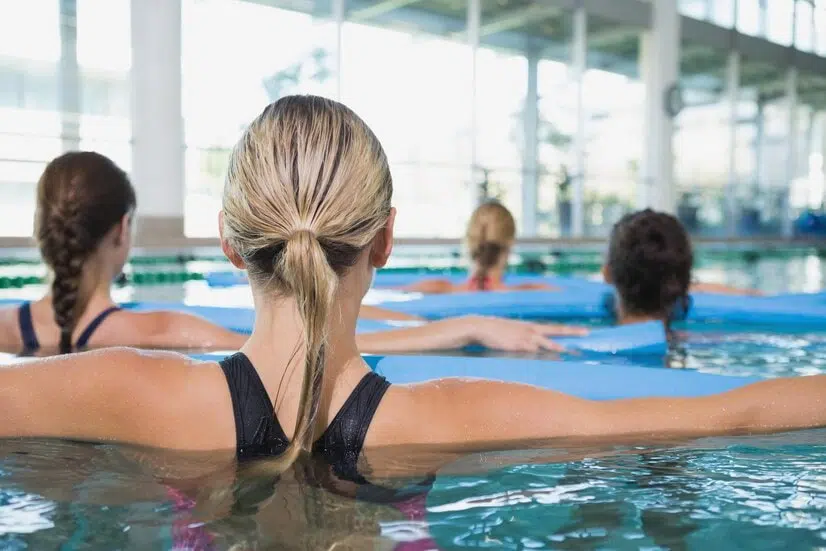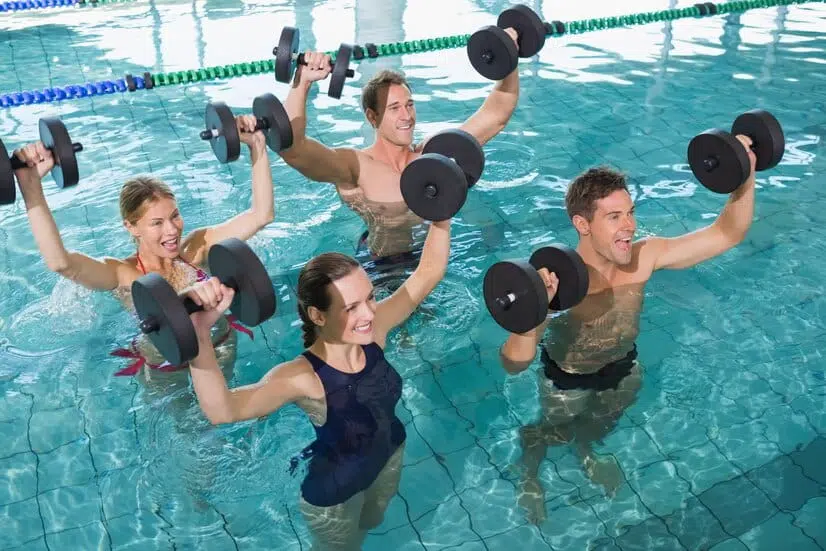Are you looking for an effective way to tone your body while protecting your joints? Aquatonus classes could be the ideal solution for you. This aquatic discipline combines muscle strengthening, endurance, and mental well-being, in a gentle and pleasant environment.
What is Aquatonus?
In this article, discover how aquatonus adapts to all levels, its specific benefits, and the exercises to obtain visible results. Ready to discover a new way to stay in shape? This article is for you.
Definition of aquatonus
Aquatonus is an aquatic discipline that combines the benefits of physical exercise with the unique properties of water. It is a varied training method, halfway between aquadynamic classes and aquawork where participants perform a series of specific exercises in the water, aimed at strengthening muscles, improving general fitness, and promoting relaxation. Thanks to the natural resistance of the water, each movement becomes more effective, allowing the muscles to be worked in depth while reducing the impact on the joints.
Origin and development of this aquatic discipline
Aquatonus has its roots in traditional methods of aquatic re-education. Over the years, this practice has developed into a discipline in its own right, integrating elements of fitness, muscle strengthening, and even relaxation. The recognized benefits of water, including its ability to lighten the body while providing increased resistance, have led to the emergence of aquatonus as a gentle but powerful alternative to land-based exercises. Today, aquatonus is practiced in many fitness centers and swimming pools, attracting a diverse audience looking for a form of exercise that is both accessible and effective.
Difference with other aquatic activities (aquagym, aquafitness)
Unlike aquagym or aquafitness, which often focus on choreographed movements or cardiovascular exercises, aquatonus focuses on more targeted and intense muscle work, while respecting the rhythm and abilities of each individual. Where aquagym focuses on the fun side and aquafitness on endurance, aquatonus stands out for its global approach, integrating both muscle strengthening exercises and relaxation techniques. It is an ideal discipline for those who want to tone their body while enjoying the benefits of water, without engaging in an activity that is too intense or technical.
Who is Aquatonus for?
Profile of practitioners
Aquatonus is aimed at a wide audience, regardless of age or fitness level. Whether you are an experienced athlete looking to diversify your workouts, someone wishing to resume gentle physical activity after a period of inactivity, or simply someone looking for a fitness method that is less stressful on the joints, aquatonus is for you. Its growing popularity among young adults aged 25 to 35 is explained by its dynamic, modern and accessible side. It is an ideal activity for those looking to combine well-being, performance and pleasure in an aquatic setting.
Adaptability to different fitness levels
One of the main advantages of aquatonus is its great adaptability. Whether you are a beginner or an experienced athlete, the exercises can be modulated according to your abilities and goals. For beginners, the movements are simplified, with a moderate intensity allowing you to acclimatize to the water and progress at your own pace. For the more experienced, the sessions can include more intense exercises and specific accessories to increase resistance and maximize muscular and cardiovascular benefits. This flexibility makes aquatonus an inclusive discipline, where everyone can progress at their own pace, without risk of injury.
Special case: aquatonus for pregnant women
Aquatonus is also a particularly beneficial activity for pregnant women. During pregnancy, the body undergoes many changes, and exercising in an aquatic environment offers valuable support. Thanks to the buoyancy of the water, the body weight is lightened, which relieves the joints and allows you to move safely. Aquatonus exercises are suitable for strengthening the muscles used during pregnancy, improving posture, and preparing the body for childbirth. In addition, water provides a feeling of well-being that helps reduce stress and tension. After birth, aquatonus remains an excellent option for getting back into shape gently.
The Fundamental Principles of Aquatonus
The properties of water exploited
Aquatonus takes advantage of the unique properties of water to provide a complete and effective workout. water resistance is one of the main assets of this discipline. Unlike air, water offers continuous resistance to each movement, forcing the muscles to work more intensely for each gesture, which strengthens and tones the body in a harmonious way. This resistance is adjustable according to the speed and amplitude of the movements, allowing the intensity of the training to be modulated according to the objectives and level of each practitioner.
There lift is another key feature of aquatonus. Through flotation, the body is partially supported by water, reducing pressure on the joints and allowing for exercises that would otherwise be difficult or painful to perform on land. This is particularly beneficial for people with joint pain, who are overweight, or who are in rehabilitation.
Finally, the hydrostatic pressure Water plays a crucial role. It exerts uniform pressure throughout the body, which helps improve blood and lymph circulation, reducing water retention and swelling. This pressure also promotes breathing by strengthening the respiratory muscles, contributing to better oxygenation of the muscles and faster recovery after exercise.
The material used
Aquatonus is practiced with simple but effective equipment. Basic equipment typically includes a pool with sufficient depth to allow for a wide variety of movements. To maximize the benefits of the sessions, specific accessories are often used, such as water dumbbells, foam noodles, and hand paddles. These tools increase the resistance of the water and allow you to target specific muscle groups, adding variety and intensity to the exercises.
There recommended dress code for aquatonus consists of a comfortable and fitted swimsuit, allowing optimal freedom of movement. For some more intense sessions, water shoes may be recommended to improve stability and protect the feet.
Aquatonus Exercises
Warm-up and preparation
Step 1: Joint mobility
Start with simple circular movements to warm up your joints. Stand in the water with your feet hip-width apart. Make circles with your arms, starting at your shoulders, then your elbows, and finally your wrists. Do 10 repetitions in each direction. Then move on to your legs: circle your ankles and knees, then gently rotate your spine, rotating your torso from left to right.
Step 2: Cardiovascular activation
Once your joints are warmed up, start walking on the spot in the water, raising your knees high. Gradually increase the pace for 2 to 3 minutes. You can then move on to jogging on the spot or gentle jumping, alternating legs. This step increases your body temperature and prepares your muscles for the effort.
Aquatonus Core Exercises
Step 1: Water Pull-Ups for Arms
Stand in the water with your feet firmly planted on the bottom of the pool. Dip your arms into the water, palms facing inward. Forcefully pull your arms toward your torso, feeling the resistance of the water. Return to the starting position and repeat 15-20 times. To increase the difficulty, use water dumbbells.
Step 2: Shoulder Circles
Place your arms at your sides. Make large, slow circles with your arms, keeping your shoulders submerged. Make 10 circles forward, then 10 backward. This movement strengthens the shoulders and improves their mobility.
Step 3: Water Row for the Back
Take a seated position while floating in the water with your legs straight out in front of you and your feet slightly sunk into the water. With your arms extended forward, pull the water toward you by bringing your elbows back. Feel your shoulder blades come together. Return to the starting position and repeat 12 to 15 times.
Lower body exercises
Step 1: Water scissors
Hold on to a board or the edge of the pool for stability. Float on your back with your legs straight out in front of you. Spread your legs wide open, then bring them together, crossing your ankles. Repeat 20 times. This exercise tones your thighs and glutes.
Step 2: Leg Extensions
Standing in the water, hold on to the edge of the pool or a bar for balance. Raise one leg straight back, keeping it straight, squeezing your glutes as much as possible. Return to the starting position and alternate with the other leg. Do 15 repetitions per leg.
Step 3: Water bike
Sit in the water, floating slightly, with your hands holding the edge of the pool for balance. Pedal as if you were on a bicycle, bringing your knees toward your chest and pushing your legs forward. Continue for 2 to 3 minutes. This move is great for sculpting your thighs and calves.
Core and balance exercises
Step 1: Floating Board
Lie on your stomach in the water, holding a kickboard in front of you. Extend your legs behind you and engage your abs to keep your body straight. Hold for 20 to 30 seconds, then release. Repeat 3 times. This exercise strengthens your core and improves balance.
Step 2: Leg lifts on plank
Lie on your back, floating on a kickboard. Slowly raise one leg toward the ceiling while keeping the other leg straight underwater. Slowly lower the leg and switch sides. Do 10 reps on each side. This move targets your abs and stabilizer muscles.
Step 3: French Fries Balancing Challenges
Place a foam noodle under each foot, and stand in the water. Try to keep your balance by standing up straight. For more of a challenge, try lifting one foot or closing your eyes. Hold for 30 seconds to 1 minute. This work improves stability and coordination.
Cardiovascular exercises
Step 1: Water sprints
Choose a section of the pool where you have room to move quickly. Alternate between 20- to 30-second sprints, where you run or swim at full speed, and 1-minute recovery periods where you walk slowly. Repeat this sequence 5 to 10 times. This exercise is great for improving endurance and boosting metabolism.
Step 2: Alternating rhythms
Start by walking or jogging gently in the water for 1 minute. Then, increase your pace for 30 seconds, then return to a slower pace for 1 minute. Alternate between paces for 10 to 15 minutes. This exercise helps burn calories while strengthening your heart and lungs.
Cool down and stretch
Step 1: Full Body Stretches
Finish your session with gentle stretches in the water. Stand at the edge of the pool with your feet planted on the floor. Stretch your arms up, then gently bend to each side to stretch your sides. Next, bring one knee toward your chest, hold it with your hands, and then switch legs. Hold each stretch for 20 to 30 seconds.
Step 2: Final relaxation
Lie on your back in the water with your arms and legs spread out to float freely. Close your eyes and breathe deeply. Focus on the feeling of the water supporting your body and allow your muscles to completely relax. Stay in this position for 2-3 minutes to end the session on a calming note.
The Benefits of Aquatonus
Physical benefits
Aquatonus offers a multitude of physical benefits, harnessing the unique properties of water to strengthen the body holistically. Muscle strengthening is one of the major benefits of this discipline. The movements performed in the water work the muscles in depth thanks to the natural resistance of the water, which allows you to tone and sculpt the entire body. The exercises target both the large muscle groups and the stabilizing muscles, often neglected in land-based training.
Aquatonus also contributes to improve cardiovascular endurance. The intense exercise sequences, alternating with recovery phases, stimulate the cardio-respiratory system, strengthening the heart and lungs. In addition, the hydrostatic pressure of the water facilitates venous return, which promotes better blood circulation and reduces the risk of cardiac fatigue.
Finally, this discipline allows you to gain in flexibility and joint mobility. The fluid movements performed in water help to stretch muscles gently, while respecting the joints. The water partially supports the body weight, which makes it easier to perform stretching exercises and with less risk of injury. This is especially beneficial for people suffering from joint stiffness or chronic pain.
Health benefits
Aquatonus is also known for its benefits on general health. By practicing regularly, you can observe a reduction of joint stress. Water lightens the body, reducing the pressure on joints during movement. This makes it an ideal activity for people suffering from arthritis, joint pain, or rehabilitating from an injury.
Another significant advantage is theimproved blood circulation. Water exerts uniform pressure on the body, which stimulates the circulatory system. This helps prevent heavy leg problems and improves muscle oxygenation, thus promoting better recovery after exercise. At the same time, aquatonus helps to stimulate the lymphatic system, which promotes the elimination of toxins and can reduce water retention and swelling.
Psychological benefits
On a psychological level, aquatonus is a real ally for mental well-being. Reducing stress and anxiety is one of the most immediate and appreciated benefits. The soothing effect of water, combined with physical activity, releases endorphins, the hormones of happiness, which instantly improve mood. Aquatonus sessions, often accompanied by a relaxed and friendly atmosphere, offer a moment of letting go that helps to evacuate accumulated tensions.
Additionally, practicing aquatonus can contribute to a improved mood and general well-being. The feeling of lightness and fluidity in the water provides a sensation of freedom and relaxation that lasts well beyond the session. This activity also strengthens the self-confidence, especially for those looking for an accessible and rewarding physical activity. Each successful session is a step closer to better physical shape and a more positive self-image.
Specific benefits for certain conditions
Aquatonus stands out for its specific benefits for certain health conditions. For example, it is extremely beneficial for the chronic pain relief. The gentle, controlled movements in the water work muscles and joints without causing additional inflammation, which is ideal for people with fibromyalgia or low back pain.
In rehabilitation, aquatonus is a valuable tool for post-traumatic rehabilitation. After an injury or surgery, practicing exercises in water helps to recover strength and mobility while minimizing the risk of relapse. Water, by supporting the body, allows you to progress more quickly and safely.
Finally, aquatonus is particularly suitable for pregnancy and postpartum support. For pregnant women, water relieves pressure on the back and joints, relieving common lower back pain. In addition, aquatonus helps maintain physical fitness during pregnancy, promoting better postpartum recovery. After birth, it allows new mothers to gently regain their muscle tone while enjoying a moment of relaxation.
Conclusion
Aquatonus is a complete and accessible aquatic discipline. It allows you to tone the body, improve endurance, and reduce stress. It is an ideal option for those looking for an effective and gentle workout for the joints.
Whether you are a beginner or an experienced athlete, aquatonus is suitable for everyone. Its benefits are numerous, both for physical condition and mental health. This practice helps you stay in shape while taking care of your body.
Go aquacycling with Aqua By
Have you never tried aquabiking? Aqua by is the perfect place to discover this activity in a unique way!
Our 45-minute sessions combine sport and relaxation, taking advantage of the benefits of water. Led by passionate coaches, our group classes guarantee efficiency and fun for all.
At Aqua by, no matter your fitness level, our sessions are tailored to everyone. After your workout, enjoy our sauna and hammam for complete relaxation.
Want to try? Book your aquabike session and dive into the world of Aqua by! Our studios in Paris (Réaumur, Bastille, Charonne) and Boulogne await you.






